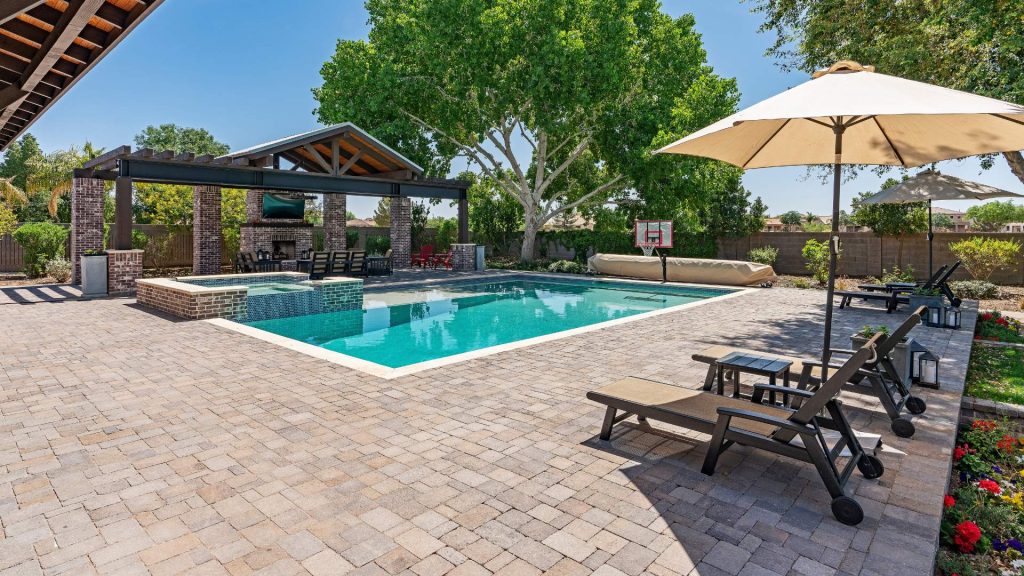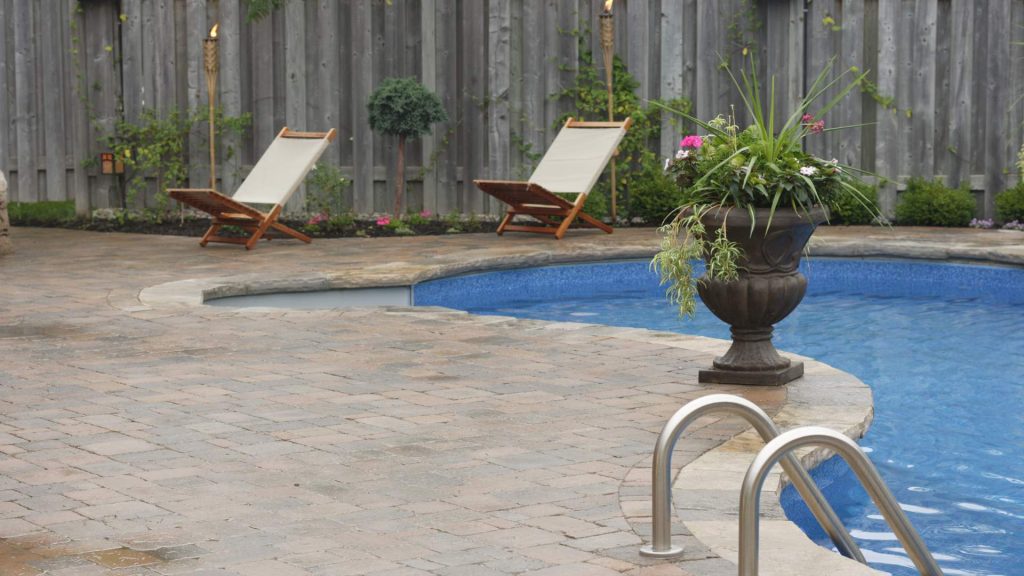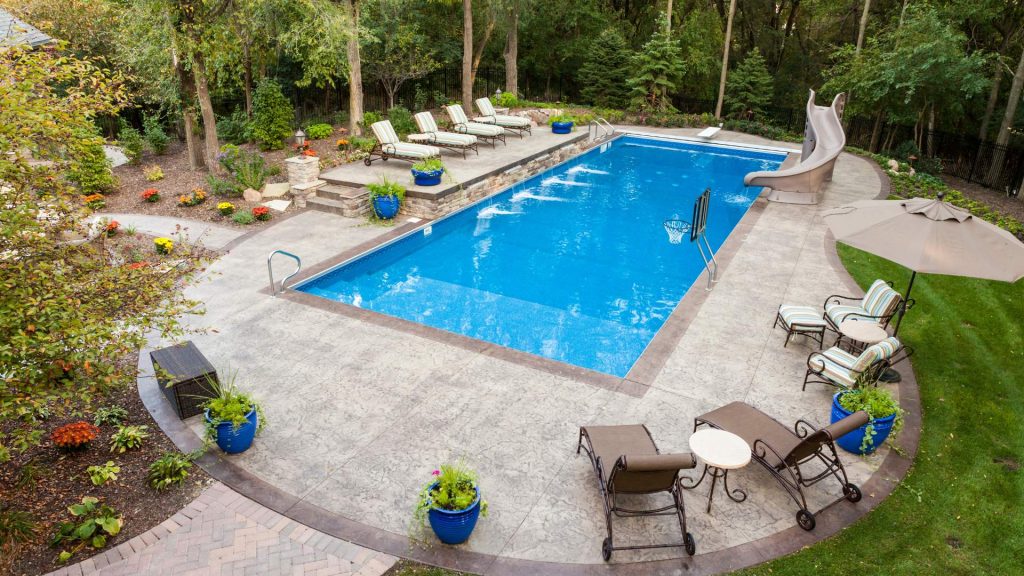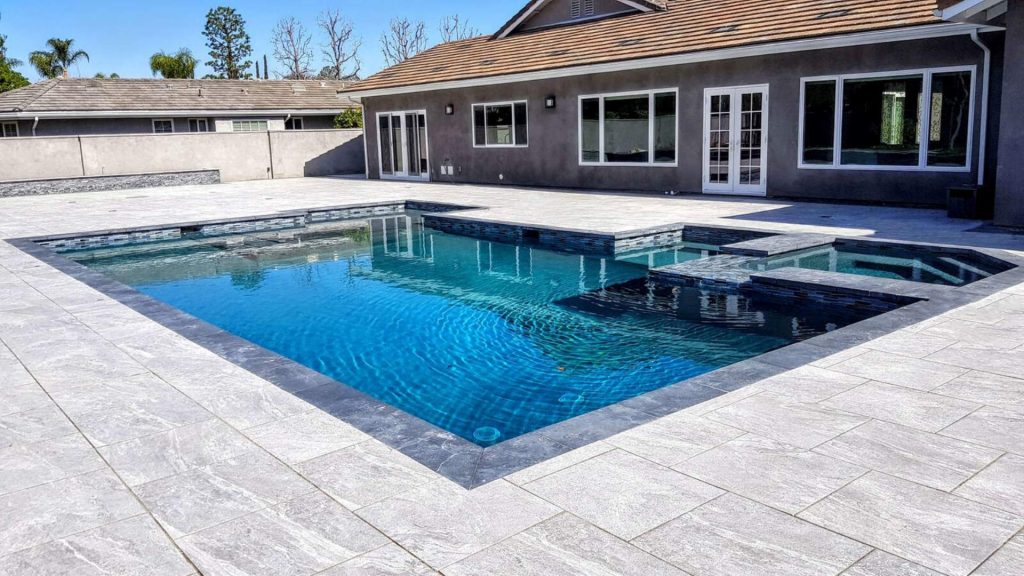Why Saltwater Changes the Rules for Pool Decks
Saltwater pools are a perfect fit for coastal lifestyle—softer on skin and eyes, less chlorine odor, and great for year‑round swimming. But salt, sun, and summer downpours can be rough on a deck surface if you pick the wrong material or finish. The right pool deck paver should be:
- Cool underfoot during July/August afternoons.
- Non‑slip in splash zones, even when sunscreen and pool water mix.
- Salt‑tolerant, so you don’t see premature etching or spalling.
- Easy to maintain, with joints that resist weeds, ants, and washout.
At Pavers of Naples, we design and install pool decks across Park Shore, Pelican Bay, and Marco Island. Below is a playbook to help you choose and build a deck that feels great, looks coastal, and lasts.
Top Materials for Saltwater Pool Decks (Local Pros & Cons)
1) Travertine (Tumbled/Antiqued Finishes)
Why homeowners love it: A timeless, resort‑style look that stays noticeably cooler underfoot in light tones. The tumbled finish offers natural traction when wet.
Best for: Pool decks and lanais in Pelican Bay, and Park Shore, where elegance and comfort matter.
Pros:
- Naturally cooler feel (especially ivory, shell, and light walnut).
- Texture = traction in splash areas.
- Subtle color movement hides everyday dust and footprints.
Considerations: - Use a breathable penetrating sealer rated for salt exposure.
- Expect natural variation—hand‑select lots for consistent tone.
- Avoid polished or honed glossy finishes outdoors.
2) Porcelain (Outdoor‑Rated, Textured)
Why homeowners choose it: Ultra‑low absorption and excellent salt resistance. Outdoor‑rated textures provide high traction without roughness.
Best for: Modern lanai/pool combos in Vanderbilt Beach, where you want an indoor‑outdoor match.
Pros:
- Extremely stain/salt resistant and color‑stable.
- Consistent sizing for tight joint lines and clean geometry.
- Tons of coastal looks (stone‑, coral‑, or wood‑effect).
Considerations: - Can feel warmer than light travertine in dark colors—choose light tones.
- Seal joints, not tile faces; confirm traction ratings for splash zones.
3) Concrete Pavers (Textured, Light Colors)
Why homeowners pick them: Budget‑smart with huge pattern options (French pattern, ashlar, plank) and border inlays for visual pop.
Best for: Large pool decks in Golden Gate Estates or where you want custom borders and inlays.
Pros:
- Versatile patterns and sizes.
- Works with permeable bands to manage splash runoff.
- Easy to lift and reset for future plumbing or lighting upgrades.
Considerations: - Choose light colors for heat; use UV‑stable sealers to slow fading.
- Aim for slip‑resistant textures; avoid smooth/polished faces.

Coping Choices That Upgrade Comfort and Safety
Your pool coping is the edge you sit on—comfort and grip matter:
- Tumbled Travertine Bullnose: Soft edges, stays cooler, classic coastal vibe.
- Porcelain Drop‑Face Coping: Clean, modern lines with a shadow‑gap effect.
- Concrete Bullnose/Chamfered: Cost‑effective and available in matching colors.
Pro tip: Use a contrasting coping color so swimmers can visually locate the edge quickly—especially helpful for evening swims and for kids.
Build for Coastal Conditions: Base, Drainage, and Joints
Even the perfect material fails without the right construction details:
Base & Bedding
- Excavate to the correct depth and compact in lifts.
- Use a screeded bedding layer for a flat, forgiving surface.
- Add edge restraint to prevent lateral creep—curves around a free‑form pool need extra attention.
Drainage & Slope
- Maintain subtle, even slope away from the pool and home (no birdbaths).
- Where splash concentrates, install channel drains or permeable relief bands to move water.
- Keep irrigation heads off pavers or use drip lines to reduce hard‑water staining.
Joints & Stabilization
- Fill joints with polymeric sand, compacted to depth and activated with a controlled mist.
- For porcelain, select fine‑grain joint products.
- Around saltwater, pair joints with a salt‑resistant, breathable sealer (stone/concrete) to lock out weeds and resist washout.

Heat, Glare & Barefoot Comfort
- Choose light, matte finishes to reduce surface temperature and glare.
- Add shade structures (sails, pergolas) over sun‑baked corners.
- Use textured surfaces with rounded edges on coping for comfortable seating.
- For kids’ splash zones, consider extra anti‑slip additives in sealer on stone or concrete.
Design Playbook: Coastal Looks That Work in Collier County
- Resort Ivory Travertine + French Pattern: Pairs with white stucco and turquoise water—a timeless coastal look.
- Porcelain Coral‑Look Planks: Seamless indoor-outdoor effect from living room to lanai—great for modern coastal homes..
- Light Concrete Ashlar + Charcoal Border: Graphic, budget‑savvy look that hides leaves and sand; add LED step lights for evening ambience.
- Shell‑inspired Color Mix: Use a pale field with shell or pearl undertones and a slightly darker coping for depth.
Safety First: Traction, Edges, and Night Lighting
- Select outdoor‑rated textures for porcelain and tumbled or brushed finishes for stone.
- Keep joint height flush with paver faces to reduce toe stubs.
- Add path and step lighting; reflection off water can create tricky shadows at night.
- Use contrasting nosing at steps and spa spillways for visibility.

Sealing Strategy for Saltwater Decks
- Travertine: Breathable penetrating sealer (natural or enhancing). Recoat every 2–3 years depending on exposure.
- Concrete: Choose UV‑stable penetrating for natural look or a film‑forming sealer for color pop; include non‑slip additive near water.
- Porcelain: Seal joints only. Clean tile faces with neutral pH products; avoid heavy film on the surface.
- Spot‑treat rust/tannin stains promptly; don’t let organics sit after storms.
Maintenance Calendar for Pool Decks
- Monthly: Rinse, blow leaves, and check splash edges and drains.
- Quarterly: Neutral clean; inspect joints and top up polymeric sand in high‑splash areas.
- Annually (Spring): Deep clean, edge check, and safety inspection before peak season.
- Every 2–3 Years: Reseal stone/concrete; refresh joints as needed.
Real‑World Examples
- Park Shore Saltwater Pool: Light tumbled travertine with bullnose coping and a subtle contrasting border. Channel drains hidden at the lanai threshold keep the deck dry after storms.
- Modern Deck: Textured porcelain planks taken straight from great room to pool, forming a seamless indoor‑outdoor run; joints sealed only.
- Golden Gate Estates Family Pool: Concrete pavers in a large ashlar with permeable bands near landscape beds; non‑slip additive in the film‑forming sealer.
FAQs
Are travertine pavers okay for a saltwater pool?
Absolutely—travertine is a top choice in light, tumbled finishes. Pair it with a breathable penetrating sealer rated for salt exposure and maintain on a 2–3 year cycle.
Will porcelain be slippery when wet?
Outdoor‑rated porcelain carries textured surfaces designed for wet traction. Confirm the manufacturer’s traction rating and keep joints sealed and clean.
What color stays coolest in sun?
Lighter tones—ivory, cream, light shell, weathered white—reflect more heat. Surface finish and shade matter too; add pergolas or sails over hot corners.
Do I need to seal a saltwater pool deck?
For stone and concrete, yes; it protects from salt, oils, and organics and stabilizes joints. Porcelain usually needs joint care only.
Can you fix slippery spots?
Yes—on stone and concrete, we can apply non‑slip additives in sealer. For porcelain, choose higher‑traction tiles and keep surfaces clean of sunscreen buildup.
How do you handle splash‑zone puddles?
We design even slope, install channel drains where needed, and add permeable bands by planters to move water away.
Final Take: Build a Deck That Loves Salt, Sun, and Splash
For saltwater pools, choose a light, textured surface with proper drainage and stabilized joints. Whether you go tumbled travertine, textured porcelain, or light concrete pavers, the secret to long‑term beauty is local‑grade installation and smart maintenance.

